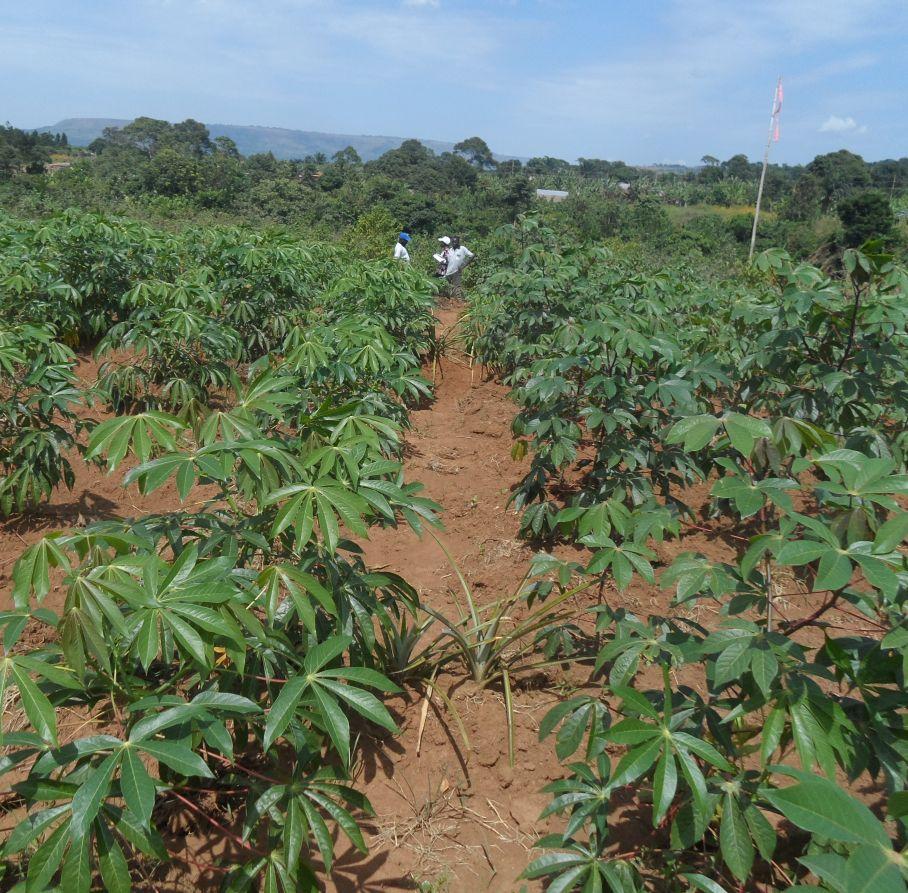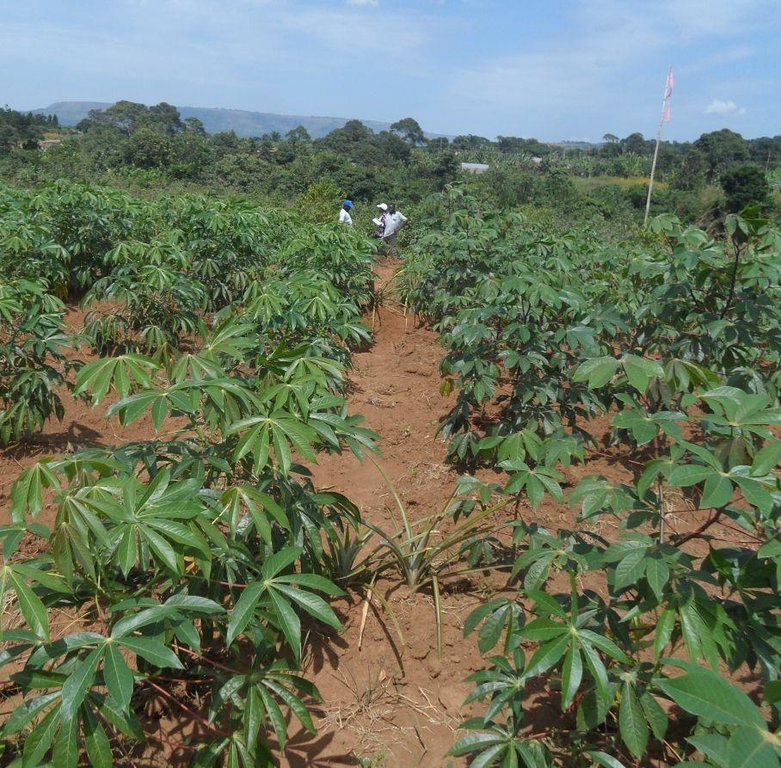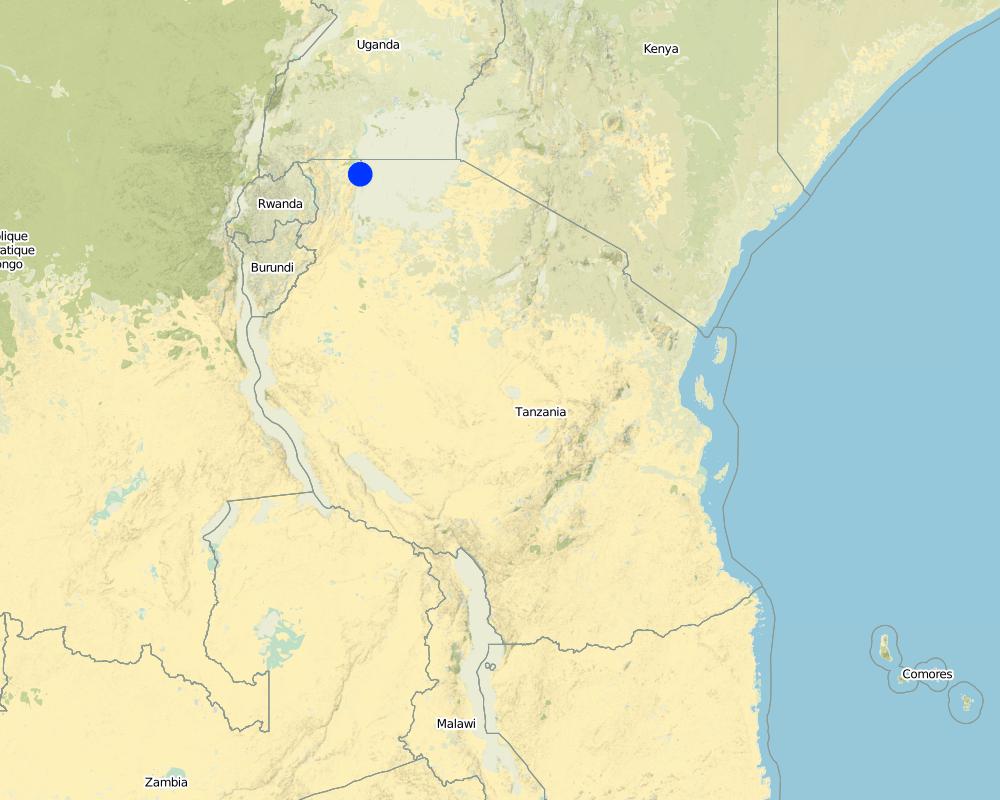Integrated agronomic measure for sustainable cassava production in convex sloppy landform [坦桑尼亚联合共和国]
- 创建:
- 更新:
- 编制者: ALLAN BUBELWA
- 编辑者: –
- 审查者: Ursula Gaemperli, Fabian Ottiger, Alexandra Gavilano
Matumizi ya matuta na vikinga maji katika kilimo cha mihogo
technologies_1201 - 坦桑尼亚联合共和国
查看章节
全部展开 全部收起1. 一般信息
1.2 参与该技术评估和文件编制的资源人员和机构的联系方式
SLM专业人员:
Kamene Nyangeta
Karonge Village
坦桑尼亚联合共和国
District council member:
Baraba Gordfrey
Bukoba District Council
坦桑尼亚联合共和国
有助于对技术进行记录/评估的机构名称(如相关)
Bukoba district council (Bukoba district council) - 坦桑尼亚联合共和国1.3 关于使用通过WOCAT记录的数据的条件
编制者和关键资源人员接受有关使用通过WOCAT记录数据的条件。:
是
1.4 所述技术的可持续性声明
这里所描述的技术在土地退化方面是否存在问题,导致无法被认为是一种可持续的土地管理技术?:
否
2. SLM技术的说明
2.1 技术简介
技术定义:
Use of contour ridging cultivation, tiles, manure application and improved genetic material for sustainable cassava production in convex sloppy landforms.
2.2 技术的详细说明
说明:
Contour ridges cultivation is a seasonal water conservation and erosion control land tilling practice aiming at improving production of cassava (Manihot esculenta), improving potential of the soil and environmental function of the land. The technology is among a list of basket of choices of SLM practices recently introduced and adapted to the area by land user working in collaboration with extension officers/SLM specialists under the auspicious support of the Tras-boundary Agro-ecosystem Management Project (Kagera TAMP).
Contour ridges are cultivated in rows across a convex slope landform of average slope category lying between 5-8%. The average height of a ridge is 0.45 -0.50m, with width lying between 0.4 -0.5m, and the distance between rows is 1 meter. To be stronger, contour ridges are tied with furrows (Tiles) dug along the slope intercepting the ridges almost perpendicular. Within a cassava block farm of average size 0.5 acres, the average length of a contour ridge is approximately 30 - 35m. Within tiles, pits are dug. The distance from one pit to another is usually 5 meters. Soils from dug pit are piled on the lower side of the slope to form a supportive bund which is stabilized and made productive by planting pineapples on it. The number of pineapples (suckers) planted on each pit bund is 3-4. Tiles provide diagonal strength to the ridges, trap runoff and allow water to infiltrate and be available to the plants. Manure application is done after contour ridging by incorporating or mixing manure with soil. Manure application at a rate of 12 tons per hectare is done before cassava planting.
Purpose of the Technology: The basic tenet of this technology is to turn a poorly managed land resource that is exposed to detrimental grazing, poor agricultural practices and uncontrolled fire burning into a managed, productive agricultural land that contribute to improved agriculture production, livelihood income and ecosystems (put the triple win solution into reality).
The rural food security and income are enhanced through soil erosion control, fertility improvement, beneficial harvesting of rainfall-runoff and use of improved cassava germ-plasm (with high resilience to climatic change and diseases and no use of chemicals).
Establishment / maintenance activities and inputs: The technology is largely agronomic dominated by seasonally repeatedly activities. The dominant recurrent activities are land preparation, contour ridging cultivation, tile digging (furrow digging, pit digging, bund making and pineapple planting), manure application, cassava planting, weeding and harvesting. The inputs needed are: tools (machete, sickles, hand holes), planting materials (cassava and pineapple), manure and labour.
The average costs per hectare of this technology is 1155.48 USD. Manure application is the most cost determinant factor and accounts for 50.89% of the total costs. Average production of cassava per hectare is 7,376.32 USD. In monetary terms the average benefit to cost ratio B/C is 6.38 exemplifying viability of the technology.
Natural / human environment: Naturally the environment encompasses cropland land use type , the technology is largely agronomic, climatic zone is sub humid with 210 length of growing period, slope category is foot slopes, the dominant soil textural class is loam with a medium soil depth. On human environment the defined level of mechanization is largely hand tools, production is mixed. land ownership is largely individual not titled and there is also communally owned land.
2.3 技术照片
2.5 已应用该技术的、本评估所涵盖的国家/地区/地点
国家:
坦桑尼亚联合共和国
区域/州/省:
Tanzania/Kagera
有关地点的进一步说明:
Bukoba rural district/Karonge
具体说明该技术的分布:
- 均匀地分布在一个区域
如果不知道精确的区域,请注明大致覆盖的区域:
- < 0.1 平方千米(10 公顷)
注释:
The area considered is a portion of area exposed to degradation and under SLM Farmer Field School training.
Map
×2.6 实施日期
如果不知道确切的年份,请说明大概的日期:
- 不到10年前(最近)
2.7 技术介绍
详细说明该技术是如何引入的:
- 通过项目/外部干预
注释(项目类型等):
Is one of the technology being promoted in Bukoba Rural District through Community integrated catchment ecosystem approach (SLM FFS approach) supported by the Kagera Trans boundary Argo-ecosystem management project (Kagera TAMP).
3. SLM技术的分类
3.1 该技术的主要目的
- 改良生产
- 减少、预防、恢复土地退化
- 创造有益的经济影响
3.2 应用该技术的当前土地利用类型

农田
- 一年一作
- 多年一作(非木材)
年作 - 具体指明作物:
- 根/块茎作物 - 木薯
多年生(非木质)作物 - 指定作物:
- 菠萝
每年的生长季节数:
- 2
具体说明:
Longest growing period in days: 120, Longest growing period from month to month: September to December Second longest growing period in days: 90 Second longest growing period from month to month: March to May
注释:
Major land use problems (compiler’s opinion): Soil erosion caused by rainfall runoff, soil infertility, poor soil moisture and poor cassava husbandry practices that contribute to low productivity.
Major land use problems (land users’ perception): Poor unproductive soil and cassava diseases.
3.5 该技术所属的SLM组
- 土壤肥力综合管理
- 改良植物品种/动物品种
3.6 包含该技术的可持续土地管理措施

农艺措施
- A2:有机质/土壤肥力
- A3:土壤表面处理
注释:
Type of agronomic measures: contour planting / strip cropping, manure / compost / residues, contour ridging, furrows (drainage, irrigation), pits
3.7 该技术强调的主要土地退化类型

土壤水蚀
- Wt:表土流失/地表侵蚀

化学性土壤退化
- Cn:肥力下降和有机质含量下降(非侵蚀所致)
注释:
Main causes of degradation: soil management (Ignorance in fertility, nutrients and moisture improvement methods, contuor ridge ploughing along the slope), crop management (annual, perennial, tree/shrub) (Poor crop husnbandry practices (use of cassava varieties prone cassava mildew, use of incorrect crop stand)), population pressure (Continuous use of the land), poverty / wealth (Incapacity to invest effectively in sustainable land managment), governance / institutional (Poor bylaw and law reinforcement especially in disease control)
Secondary causes of degradation: deforestation / removal of natural vegetation (incl. forest fires) (Uncontrolled fire burning, poor agricultural methods (biasness to land expansion rather than intensification)), change in temperature (Due to climatic change and variability), change of seasonal rainfall (Due to climatic change and variability), Heavy / extreme rainfall (intensity/amounts) (Due to climatic change and variability), droughts (Due to climatic change and variability)
3.8 防止、减少或恢复土地退化
具体数量名该技术与土地退化有关的目标:
- 防止土地退化
- 减少土地退化
4. 技术规范、实施活动、投入和成本
4.1 该技术的技术图纸
技术规范(与技术图纸相关):
echnical knowledge required for field staff / advisors: low (Skills and knowledge on contour ridging cultivation, use of tiles and manuring can easily be acquired by field staff and spread to farmers.)
Technical knowledge required for land users: moderate (Skills and knowledge on contour ridging cultivation, use of tiles and manuring are simple and can easily be learn and adopted by farmers through FFS training.)
Main technical functions: control of dispersed runoff: impede / retard, control of concentrated runoff: retain / trap, increase in nutrient availability (supply, recycling,…), increase of infiltration, increase / maintain water stored in soil
Contour planting / strip cropping
Material/ species: Cassava cuttings
Quantity/ density: 10000/ha
Remarks: crop stand per hactere (spacing 1mx1m)
Agronomic measure: tile pit stabilization
Material/ species: Pineapples planted to stabilize pits
Quantity/ density: 180
Remarks: pineapples sucker in one ha
Manure / compost / residues
Material/ species: Cow dung (tonnes)
Quantity/ density: 35 t/ha
Remarks: Spread along farm
Contour ridging
Material/ species: Cultivated ridges across the slope
Quantity/ density: 24 r/ha
Remarks: Space between rows is 1m
Furrows (drainage, irrigation)
Material/ species: Tiles dug along the slope
Quantity/ density: 6 tiles/ha
Remarks: Space between tiles is 8m
Pits
Material/ species: Water collection pits dug within furrow/tile
Quantity/ density: 12pits/ha
Remarks: 2 pits/tile. each tile stabilized by 3-4 pinneapples
4.2 有关投入和成本计算的一般信息
其它/国家货币(具体说明):
Tanzanian shillings
如相关,注明美元与当地货币的汇率(例如1美元=79.9巴西雷亚尔):1美元=:
1700.0
注明雇用劳工的每日平均工资成本:
1.50
4.3 技术建立活动
| 活动 | 时间(季度) | |
|---|---|---|
| 1. | tools |
4.4 技术建立所需要的费用和投入
| 对投入进行具体说明 | 单位 | 数量 | 单位成本 | 每项投入的总成本 | 土地使用者承担的成本% | |
|---|---|---|---|---|---|---|
| 设备 | Tools | pieces | 36.0 | 2.9167 | 105.0 | 100.0 |
| 植物材料 | cassava cuttings | 1.0 | ||||
| 肥料和杀菌剂 | compost/manure | 1.0 | ||||
| 技术建立所需总成本 | 105.0 | |||||
| 技术建立总成本,美元 | 0.06 | |||||
注释:
Duration of establishment phase: 1 month(s)
Lifespan of the tools: 5 years
4.5 维护/经常性活动
| 活动 | 时间/频率 | |
|---|---|---|
| 1. | Land preparation (clearing and ploughing) | November |
| 2. | Contour ridging cultivation combined with tiles. | December |
| 3. | Manure application | December |
| 4. | Procurement of improved cassava varieties (Mkombozi) and pineapple suckers. | December |
| 5. | Planting cassava and pineapple | December |
| 6. | Weeding | February and September |
| 7. | Harvesting | Once annualy |
4.6 维护/经常性活动所需要的费用和投入(每年)
| 对投入进行具体说明 | 单位 | 数量 | 单位成本 | 每项投入的总成本 | 土地使用者承担的成本% | |
|---|---|---|---|---|---|---|
| 劳动力 | Land preparation | person/days | 45.0 | 1.17777 | 53.0 | 100.0 |
| 劳动力 | Contour ridging cultivation combined with tiles. | person/days | 60.0 | 1.46666 | 88.0 | 100.0 |
| 劳动力 | Manure application | person/days | 30.0 | 1.46666 | 44.0 | 100.0 |
| 劳动力 | Planting cassava and pineapple | person/days | 13.0 | 1.154 | 15.0 | 100.0 |
| 设备 | Tools | 1.0 | 100.0 | |||
| 植物材料 | cassava cuttings | pieces | 10000.0 | 0.017648 | 176.48 | |
| 植物材料 | pineapple suckers | pieces | 180.0 | 0.28888888 | 52.0 | |
| 肥料和杀菌剂 | Compost/manure | Tons | 12.0 | 49.0 | 588.0 | |
| 其它 | Labour: Weeding | person/days | 26.0 | 0.577 | 15.0 | 100.0 |
| 其它 | Labour: Harvesting | person/days | 26.0 | 0.7307 | 19.0 | 100.0 |
| 技术维护所需总成本 | 1050.48 | |||||
| 技术维护总成本,美元 | 0.62 | |||||
注释:
Machinery/ tools: machete, hand hoe (flat and fork) and sickles.
Labour, tools, manure and planting materials per hectare of land subjected to technology/under cassava production.
4.7 影响成本的最重要因素
描述影响成本的最决定性因素:
Manuring is the most determinant factor affecting the costs.
5. 自然和人文环境
5.1 气候
年降雨量
- < 250毫米
- 251-500毫米
- 501-750毫米
- 751-1,000毫米
- 1,001-1,500毫米
- 1,501-2,000毫米
- 2,001-3,000毫米
- 3,001-4,000毫米
- > 4,000毫米
有关降雨的规范/注释:
Long sesaon September to December, short season March to May. September to December 180 days, March to May 90 days, Total 210
农业气候带
- 半湿润
Thermal climate class: tropics. Average 21°C
5.2 地形
平均坡度:
- 水平(0-2%)
- 缓降(3-5%)
- 平缓(6-10%)
- 滚坡(11-15%)
- 崎岖(16-30%)
- 陡峭(31-60%)
- 非常陡峭(>60%)
地形:
- 高原/平原
- 山脊
- 山坡
- 山地斜坡
- 麓坡
- 谷底
垂直分布带:
- 0-100 m a.s.l.
- 101-500 m a.s.l.
- 501-1,000 m a.s.l.
- 1,001-1,500 m a.s.l.
- 1,501-2,000 m a.s.l.
- 2,001-2,500 m a.s.l.
- 2,501-3,000 m a.s.l.
- 3,001-4,000 m a.s.l.
- > 4,000 m a.s.l.
说明该技术是否专门应用于:
- 凸形情况
关于地形的注释和进一步规范:
Slopes on average: Moderate (Convex foot slope of average slope category of 5-8%)
5.3 土壤
平均土层深度:
- 非常浅(0-20厘米)
- 浅(21-50厘米)
- 中等深度(51-80厘米)
- 深(81-120厘米)
- 非常深(> 120厘米)
土壤质地(表土):
- 中粒(壤土、粉土)
表土有机质:
- 中(1-3%)
- 低(<1%)
如有可能,附上完整的土壤描述或具体说明可用的信息,例如土壤类型、土壤酸碱度、阳离子交换能力、氮、盐度等。:
Soil depth on average: Moderately deep (moderate deep loam soil)
Soil fertility: Low
Soil drainage/infiltration: Medium
Soil water storage capacity: Medium
5.4 水资源可用性和质量
地下水位表:
> 50米
地表水的可用性:
中等
5.6 应用该技术的土地使用者的特征
非农收入:
- 低于全部收入的10%
相对财富水平:
- 贫瘠
- 平均水平
说明土地使用者的其他有关特征:
4% of the land users are rich and own 32% of the land.
32% of the land users are average wealthy and own 64% of the land.
64% of the land users are poor and own 4% of the land.
Off-farm income specification: Most run local bar
5.7 应用该技术的土地使用者使用的平均土地面积
- < 0.5 公顷
- 0.5-1 公顷
- 1-2 公顷
- 2-5公顷
- 5-15公顷
- 15-50公顷
- 50-100公顷
- 100-500公顷
- 500-1,000公顷
- 1,000-10,000公顷
- > 10,000公顷
注释:
Average area of land owned or leased by land users applying the Technology:
< 0.5 ha (ranked 2, poor farmers account for about 25%)
0.5-1 ha (ranked 1, medium farmer account for about 60%)
1-2 ha (ranked 3, rich farmers account for about 15%)
5.8 土地所有权、土地使用权和水使用权
土地所有权:
- 个人,未命名
注释:
Land is acquired through inheritance or purchase from farmers owning the land.
5.9 进入服务和基础设施的通道
健康:
- 贫瘠
- 适度的
- 好
教育:
- 贫瘠
- 适度的
- 好
技术援助:
- 贫瘠
- 适度的
- 好
就业(例如非农):
- 贫瘠
- 适度的
- 好
市场:
- 贫瘠
- 适度的
- 好
能源:
- 贫瘠
- 适度的
- 好
道路和交通:
- 贫瘠
- 适度的
- 好
饮用水和卫生设施:
- 贫瘠
- 适度的
- 好
6. 影响和结论性说明
6.1 该技术的现场影响
社会经济效应
生产
作物生产
SLM之前的数量:
12
SLM之后的数量:
24
木材生产
生产故障风险
SLM之前的数量:
12
SLM之后的数量:
0
产品多样性
注释/具体说明:
Only food
生产区域
注释/具体说明:
Few adopters
土地管理
收入和成本
农业投入费用
SLM之前的数量:
30 dollars
SLM之后的数量:
940 dollas
注释/具体说明:
Due to manue application, purchase of improved cartivars and suckers
农业收入
SLM之前的数量:
600
SLM之后的数量:
1200
工作量
注释/具体说明:
Weeding is done once. Needs a lot more labour, hired labourers
社会文化影响
食品安全/自给自足
SLM之前的数量:
0.3
SLM之后的数量:
0.7
注释/具体说明:
Demo site only
SLM/土地退化知识
注释/具体说明:
Very few adoption
社会经济弱势群体的情况
注释/具体说明:
Few widows
Improved livelihoods and human well-being
注释/具体说明:
Increased productivity above 50% leading to increase income and farmers capacity to invest in education and health.
生态影响
水循环/径流
水的回收/收集
地表径流
注释/具体说明:
Close ridges
多余水的排放
土壤
土壤覆盖层
养分循环/补给
注释/具体说明:
Residuals
土壤有机物/地下C
注释/具体说明:
Manure application
生物多样性:植被、动物
生物量/地上C
注释/具体说明:
Residuals
害虫/疾病控制
注释/具体说明:
Pure stand
减少气候和灾害风险
火灾风险
注释/具体说明:
Guarding
6.3 技术对渐变气候以及与气候相关的极端情况/灾害的暴露和敏感性(土地使用者认为的极端情况/灾害)
渐变气候
渐变气候
| 季节 | 增加或减少 | 该技术是如何应对的? | |
|---|---|---|---|
| 年温度 | 增加 | 不好 |
气候有关的极端情况(灾害)
气象灾害
| 该技术是如何应对的? | |
|---|---|
| 局地暴雨 | 不好 |
| 局地风暴 | 未知 |
气候灾害
| 该技术是如何应对的? | |
|---|---|
| 干旱 | 不好 |
水文灾害
| 该技术是如何应对的? | |
|---|---|
| 比较和缓的(河道)洪水 | 未知 |
其他气候相关的后果
其他气候相关的后果
| 该技术是如何应对的? | |
|---|---|
| 缩短生长期 | 不好 |
注释:
Contour ridging cultivation strengthened with Tiles or furrow dug along the slope intercepting ridges almost perpendicular. Each tile has 2 pits dug at an average distance of 5meters. The dug pits have supportive bunds on the lower side of the slope and the bunds is stabilized by planting pineapples. Tiles improve tolerance of ridge to seasonal rainfall decrease.
6.4 成本效益分析
技术收益与技术建立成本相比如何(从土地使用者的角度看)?
短期回报:
积极
长期回报:
非常积极
技术收益与技术维护成本/经常性成本相比如何(从土地使用者的角度看)?
短期回报:
积极
长期回报:
非常积极
注释:
The quality of cassava has improved and there is an increase in productivity. In general rewards are realized within a short term i.e. benefit accrued from cassava surpass the initial investment costs.
6.5 技术采用
如若可行,进行量化(住户数量和/或覆盖面积):
50 households and 10% of the area covered
在所有采用这项技术的人当中,有多少人是自发的,即未获得任何物质奖励/付款?:
- 11-50%
注释:
25 land user families have adopted the Technology with external material support
Comments on acceptance with external material support: 80% of farmers accepted the technology through material support.
25% of land user families have adopted the Technology without any external material support
25 land user families have adopted the Technology without any external material support
Comments on spontaneous adoption: As the technology was introduced recently percentage adoption through own investment is low but farmers are impressed by benefit accrued from the technology and there is expectation that in the long run voluntary adoption is to be observed.
There is a little trend towards spontaneous adoption of the Technology
Comments on adoption trend: There is a vivid evidence of technology adoption and in the near future significant technology adoption is expected to be realized.
6.7 该技术的优点/长处/机会
| 土地使用者眼中的长处/优势/机会 |
|---|
| Group strength and cohesiveness. |
| 编制者或其他关键资源人员认为的长处/优势/机会 |
|---|
| The technology contributes to soil erosion control, improved soil fertility and improved soil moisture. |
| There is increase in cassava productivity and income accrued from sell of cassava. |
| The technology promote diversification of income sources (cassava and pineapples) |
| Poorly managed land is changed into well managed and beneficial productive agricultural land. |
| Increased farmers commitment to mitigate land degradation |
6.8 技术的弱点/缺点/风险及其克服方法
| 土地使用者认为的弱点/缺点/风险 | 如何克服它们? |
|---|---|
| High expectation due to promissory at the project beginning | Stick and give emphasis to project objectives. |
| Slow and weak response of some farmers (group dynamics) | Enhance access to quality extension services. |
| Material support ideology | Change mindset of farmer from material incentive to self mobilization |
| Community ignorance in land protective bylaws | Awareness creation of farmers to laws and act guiding environmental conservation and reinforce use of bylaws. |
| Never attended any study tours | Introduce look and learn tour for farmers to see and learn best practices. |
| 编制者或其他关键资源人员认为的弱点/缺点/风险 | 如何克服它们? |
|---|---|
| High initial investment capital (manure is the most cost determinant factor) | Establishment of rural micro finance institutions and formation of inter group farmer associations and networks. |
| Post harvest losses, farmer ignorance in Cassava value addition technologies and tendencies to sell cassava at farm gate dilutes maximum profit realization. | Support to post harvest technology and value addition technologies for maximum realization of profit. |
| Shortage of improved planting materials (germ plasma) | Liaise with research station for adequate multiplication and distribution of improved planting materials. |
7. 参考和链接
7.1 信息的方法/来源
- 实地考察、实地调查
- 与土地使用者的访谈
(现场)数据是什么时候汇编的?:
26/05/2014
链接和模块
全部展开 全部收起链接
无链接
模块
无模块




